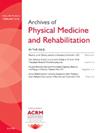Evaluating Racial Disparities in Food Access and Their Impact on Body Mass Index Among Individuals With Traumatic Spinal Cord Injury
IF 3.7
2区 医学
Q1 REHABILITATION
Archives of physical medicine and rehabilitation
Pub Date : 2025-10-01
DOI:10.1016/j.apmr.2025.02.013
引用次数: 0
Abstract
Objective
To investigate racial disparity in food access and its effect on obesity (measured by body mass index, BMI) among individuals with traumatic spinal cord injury (tSCI).
Design
Cross-sectional analysis of data from the U.S. National Spinal Cord Injury Database linked with the United States Department of Agriculture Food Access Research Atlas, examining participants’ residences in low-income, low-access (LILA) areas and their BMI.
Setting
Data were collected from U.S. Spinal Cord Injury Model Systems centers, with participants living in various communities.
Participants
A final sample of individuals with tSCI (n=4177) was included, selected based on their completion of follow-up assessments between October 2006 and November 2021. Participants were aged >19 years and self-identified as non-Hispanic White, non-Hispanic Black, or Hispanic. Other racial/ethnic groups were excluded because of small sample sizes.
Interventions
Not applicable.
Main Outcome Measures
The primary outcome measure was obesity, defined as BMI ≥30 kg/m². Food access was categorized using the United States Department of Agriculture criteria for LILA tracts.
Results
Significant racial disparities in food access were observed, with 21.7% of non-Hispanic Black and 13.9% of Hispanic individuals residing in LILA tracts, compared with 7.9% of non-Hispanic White individuals (P<.05). However, living in a LILA tract was not significantly associated with increased obesity risk (odds ratio, 1.22; 95% confidence interval, 0.97-1.54; P=.09).
Conclusions
Our data revealed racial inequity in food access among individuals with tSCI, with minoritized groups being disproportionately affected. However, no significant association was found between food access and obesity. Future studies are needed to explore how food access interacts with other factors affecting health outcomes in this population.
评估外伤性脊髓损伤个体食物获取的种族差异及其对体重指数的影响。
目的调查食物获取方面的种族差异及其对外伤性脊髓损伤(tSCI)患者肥胖(以体重指数衡量)的影响:设计:对美国国家脊髓损伤数据库(NSCID)与美国农业部食物获取研究图集(USDA Food Access Research Atlas)相连接的数据进行横断面分析,研究参与者在低收入、低获取率(LILA)地区的居住情况及其体重指数:数据收集自美国脊髓损伤模型系统(SCIMS)中心,参与者居住在不同的社区:根据 2006 年 10 月至 2021 年 11 月期间完成的随访评估结果,共纳入 4,177 名 tSCI 患者。参与者年龄大于 19 岁,自我认同为非西班牙裔白人、非西班牙裔黑人或西班牙裔。由于样本量较小,不包括其他种族/族裔群体:主要结果测量指标:主要结果测量指标为肥胖,定义为体重指数≥30 kg/m²。根据美国农业部对 LILA 地区的标准对食物获取情况进行分类:结果发现,在食物获取方面存在明显的种族差异,21.7% 的非西班牙裔黑人和 13.8% 的西班牙裔人居住在 LILA 地区,而非西班牙裔白人居住在 LILA 地区的比例仅为 7.9%(p 结论:我们的数据揭示了食物获取方面的种族不平等:我们的数据揭示了患有慢性粒细胞白血病的人群在获取食物方面的种族不平等,少数民族人群受到的影响尤为严重。然而,在食物获取与肥胖之间并没有发现明显的关联。未来的研究需要探索食物获取与影响该人群健康结果的其他因素之间的相互作用。
本文章由计算机程序翻译,如有差异,请以英文原文为准。
求助全文
约1分钟内获得全文
求助全文
来源期刊
CiteScore
6.20
自引率
4.70%
发文量
495
审稿时长
38 days
期刊介绍:
The Archives of Physical Medicine and Rehabilitation publishes original, peer-reviewed research and clinical reports on important trends and developments in physical medicine and rehabilitation and related fields. This international journal brings researchers and clinicians authoritative information on the therapeutic utilization of physical, behavioral and pharmaceutical agents in providing comprehensive care for individuals with chronic illness and disabilities.
Archives began publication in 1920, publishes monthly, and is the official journal of the American Congress of Rehabilitation Medicine. Its papers are cited more often than any other rehabilitation journal.

 求助内容:
求助内容: 应助结果提醒方式:
应助结果提醒方式:


